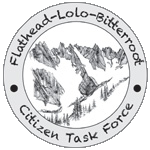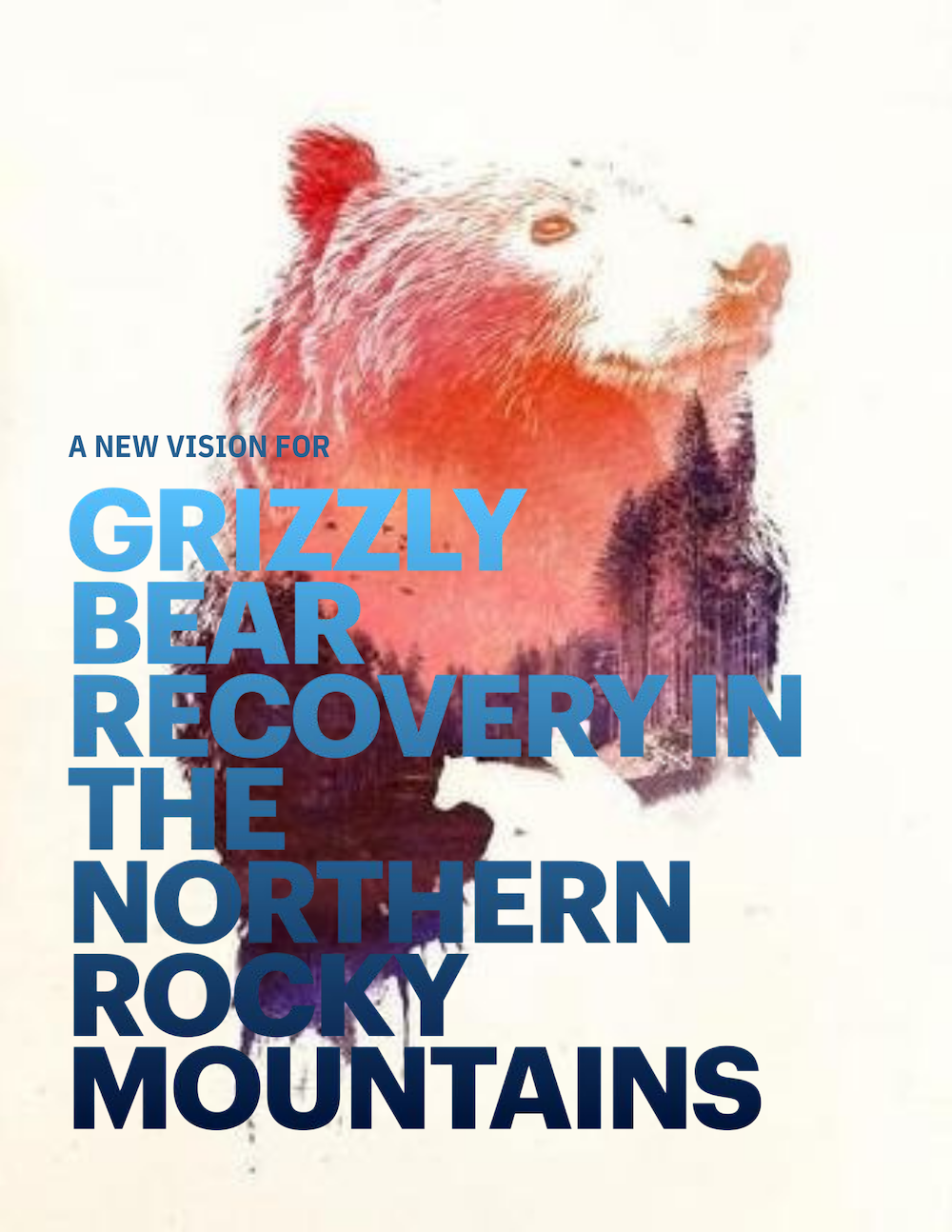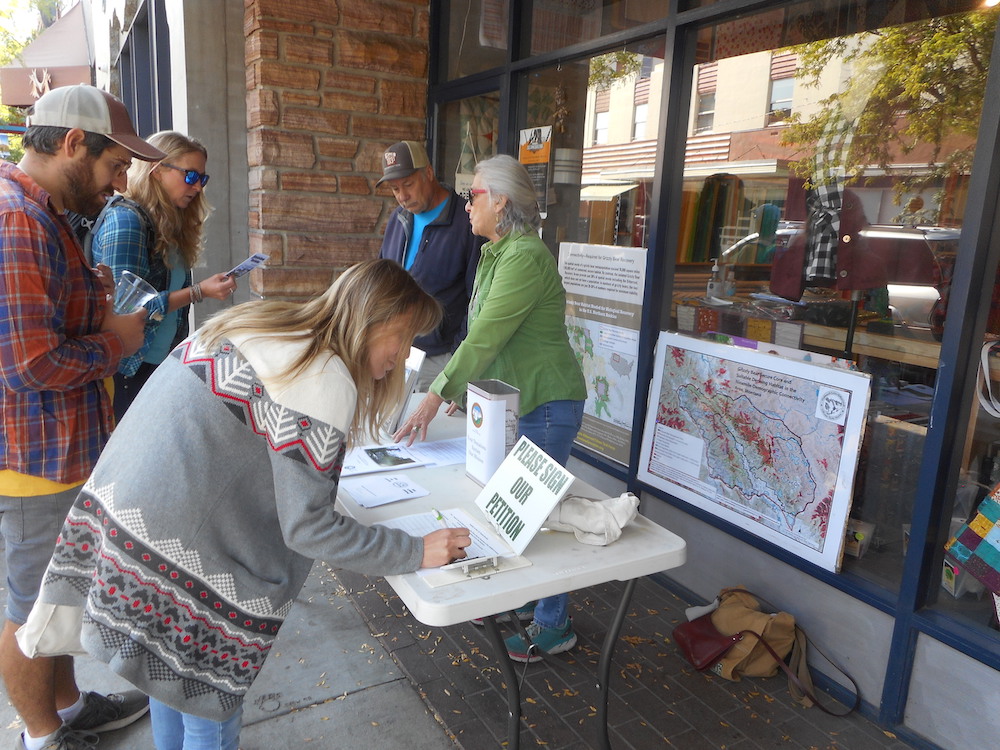A New Vision for Grizzly Bear Recovery in the Northern Rocky Mountains
Bolsters support for a unified, interconnected grizzly bear population
Titled “A New Vision for Grizzly Bear Recovery in the Northern Rockies,” the report from nine conservation groups provides a list of actions, policies, and practices to address human conflicts, and offers recommendations for improving and protecting grizzly bear habitat. The report also promotes stewardship and protection of private lands, ways to fix inadequate governance, and adapting grizzly bear recovery efforts to climate change.
Download A New Vision for Grizzly Bear Recovery in the Northern Rocky Mountains (PDF, 2.0MB)
New Report: Metapopulation Approach the Only Way to Recover Grizzly Bears
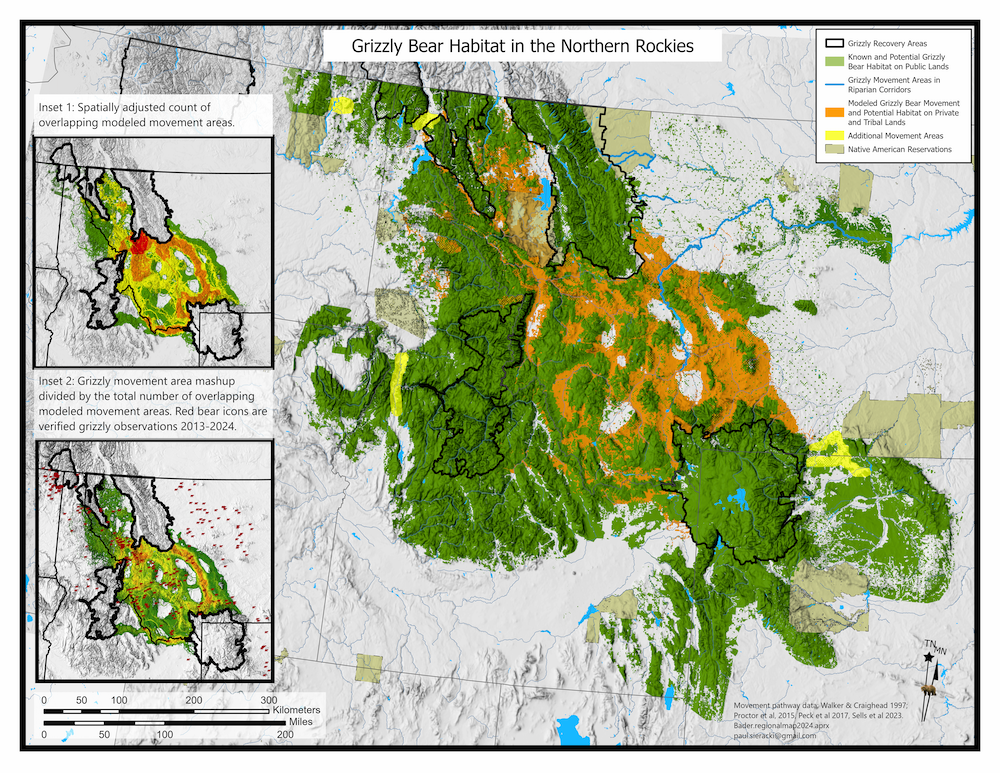 A new report, “Spatiotemporal Dimensions of Grizzly Bear Recovery,” (attached) shows that grizzly bears cannot survive in the isolated Recovery Areas. For long term viability the populations must be unified through demographic connectivity into a metapopulation.
A new report, “Spatiotemporal Dimensions of Grizzly Bear Recovery,” (attached) shows that grizzly bears cannot survive in the isolated Recovery Areas. For long term viability the populations must be unified through demographic connectivity into a metapopulation.
Download the Report Spatiotemporal Dimensions of Grizzly Bear Recovery (PDF)
Download High Resoultion Map (JPG)
Download the Press Release (Word Doc)
Preliminary Injunction Against Wolf Trapping In Grizzly Bear Habitat

Thanks to your support we are having success in protecting grizzly bears and other carnivores and predators and defending their habitat.
The Task Force, along with WildEarth Guardians sued the State of Montana and filed a motion for a preliminary injunction against wolf trapping in grizzly bear habitat in Montana except from January 1- February 15, when most grizzly bears will be in their dens. We were aided by the depositions of seven grizzly bear and wolf experts.
Following an oral hearing, the District Court granted the injunction. This decision was appealed by the State to the 9th Circuit Court of Appeals and an oral hearing took place in Pasadena, CA. The 9th then ruled to uphold the injunction. The Task Force filed a motion for summary judgment and requested that recreational coyote trapping be added to the injunction. The briefing on summary judgment is complete and there will be an oral hearing before the District Court on June 25th.
A similar case in Idaho resulted in a permanent injunction against wolf trapping in grizzly habitat for most of the year including all districts bordering Montana.
9th Circuit Ruling (PDF)
Mattson Report (PDF)
Media Story (PDF)
Natural Grizzly Bear Repopulation in the Greater Bitterroot Ecosystem
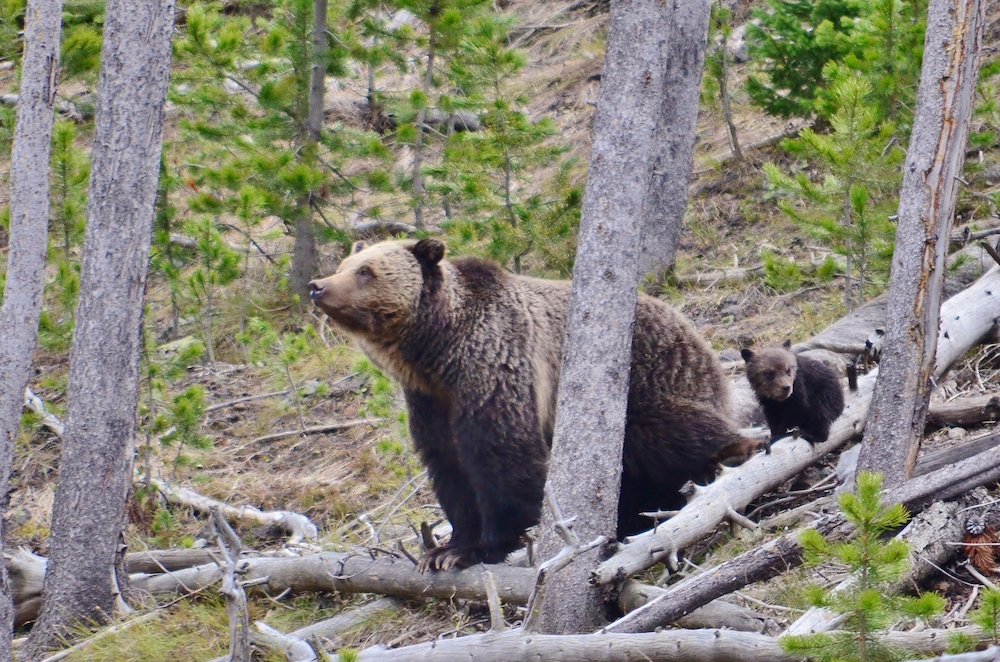 Photo Credit: van Manen/USFWS
Photo Credit: van Manen/USFWS
A new report from the Flathead-Lolo-Bitterroot Citizen Task Force and WildEarth Guardians authored by independent researchers Mike Bader and Paul Sieracki is now available. Prepared for the new Bitterroot Grizzly Bear Recovery EIS process, the report estimates that female grizzlies may reach the Bitterroot Ecosystem (BE) within the next decade. Based on verified observations of females with cubs and new published research on female grizzly bear habitat connectivity, potential routes to the Bitterroot are used to help show where and how soon female grizzly bears may reach the BE.
Specifically, the report also estimates the contiguous Northern Continental Divide Ecosystem population could move six miles into the BE within 5 years, and after 15 years move 18-25 miles to occupy more of the area. At that point dispersers ahead of the main population would move deeper into the BE.
Many grizzly bears have already reached the BE and adjacent areas including a verified den site, verified photographs and tracks. A federal court ruling in Alliance for the Wild Rockies v. Cooley found the old U.S. Fish & Wildlife Service plan designating an “experimental, non-essential population” is no longer valid and a new EIS must be completed by October, 2026.
The report argues against moving grizzly bears by trucks or other human-assisted means to get female grizzly bears to the BE stating: “Natural immigration is a viable strategy which must be considered and fully analyzed in the upcoming EIS. We believe that the law and the science direct that the Bitterroot Ecosystem grizzly bear recovery strategy be based on natural immigration facilitated by protected habitat connectivity areas and with the full protection of the Endangered Species Act.”
Scientists have long said that reoccupation of the Bitterroot Ecosystem is required for long term recovery of grizzly bears in the Northern Rockies. The key to this is habitat areas that connect isolated Recovery Areas and reduction of human-related mortality.
The report offers a number of recommendations, including:
● Minimizing all forms of mortality caused by people;
● Constructing wildlife crossings over highways and rail lines at key locations to allow grizzlies safe passage across them;
● Expanding rules to improve food storage and other attractants, like garbage, so it doesn’t attract bears and create conflicts with people;
● Reducing road densities within areas of connectivity;
● Substantially increasing the core Bitterroot Recovery Area.
Download the report (PDF)
Bitterroot Grizzly Bear Recovery
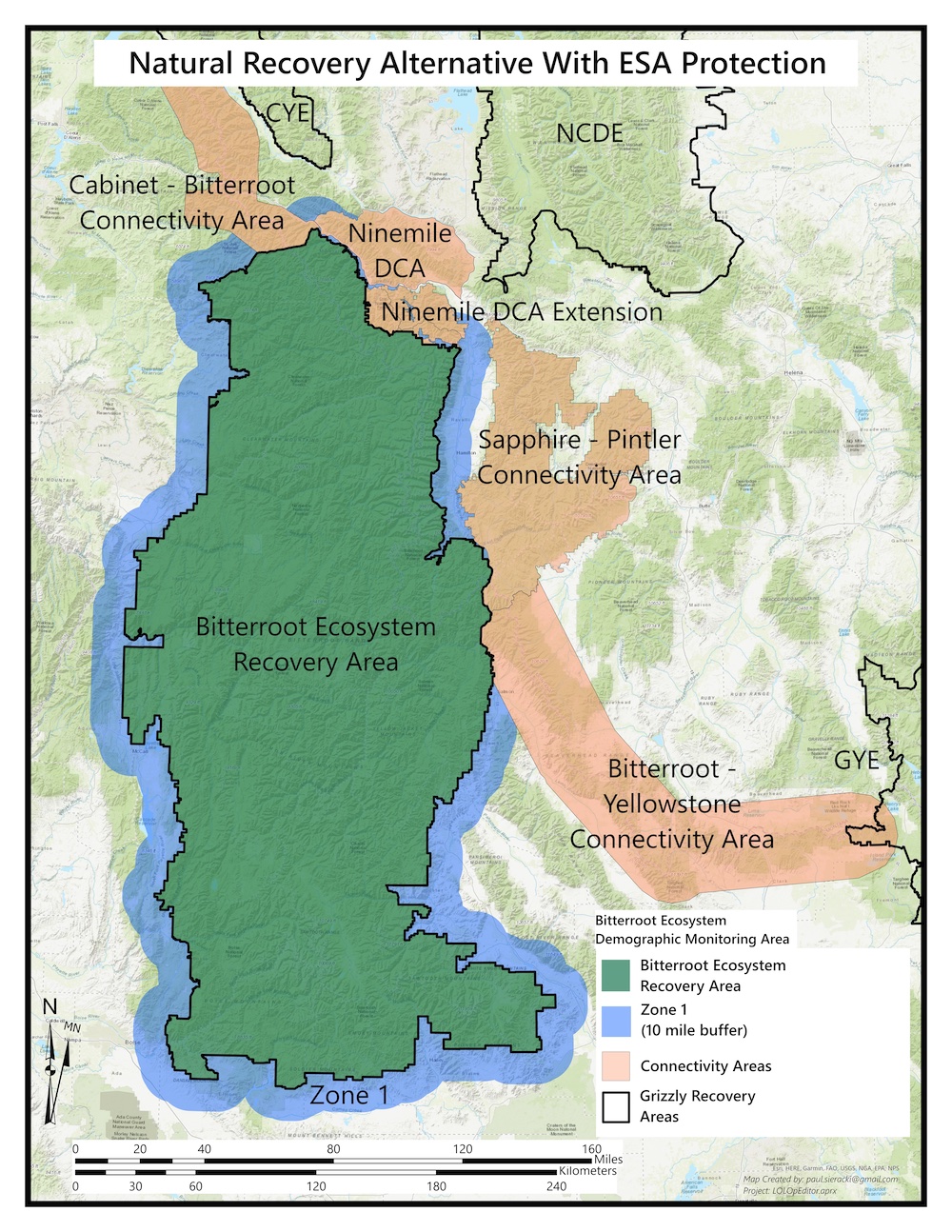 The US Fish & Wildlife Service has begun the process for a new Bitterroot Grizzly Bear Recovery EIS. Along with other groups we submitted a citizen alternative for natural grizzly bear recovery with ESA protections and habitat connectivity areas we seek to have considered as a formal alternative. During the comment period we also submitted extensive comments on issues the EIS must address. The USFWS is currently drafting alternatives it will release for public comments sometime this summer or fall.
The US Fish & Wildlife Service has begun the process for a new Bitterroot Grizzly Bear Recovery EIS. Along with other groups we submitted a citizen alternative for natural grizzly bear recovery with ESA protections and habitat connectivity areas we seek to have considered as a formal alternative. During the comment period we also submitted extensive comments on issues the EIS must address. The USFWS is currently drafting alternatives it will release for public comments sometime this summer or fall.
Citizen Alternative (PDF)
Public Comments (PDF)
Map (14MB, JPG)
Media Stories: Missoulian Part 1, Missoulian Part 2 (PDF)
Another aspect is the possible delisting of grizzly bears in the NCDE and GYE with state management and trophy hunting. Decisions are expected soon. We were part of the Great Bear Gathering where we discussed the challenges and tactics.
Conservation groups file for injunction to halt Montana wolf trapping, protect grizzly bears
Advocates seek stop to Montana’s 2023 wolf trapping season pending a court decision on alleged Endangered Species Act violations
 Photo Credit: van Manen/USFWSConservation groups moved on Friday to enjoin Montana’s 2023 wolf trapping season on the grounds that the trapping harms federally-protected grizzly bears in the state. The groups, the Flathead-Lolo-Bitterroot Citizen Task Force and WildEarth Guardians, called for the preliminary injunctionas part of a lawsuit against the State of Montana alleging that new trapping regulations, which expand wolf trapping in grizzly habitat,cause unlawful “take” of grizzlies in violation of the Endangered Species Act (ESA).
Photo Credit: van Manen/USFWSConservation groups moved on Friday to enjoin Montana’s 2023 wolf trapping season on the grounds that the trapping harms federally-protected grizzly bears in the state. The groups, the Flathead-Lolo-Bitterroot Citizen Task Force and WildEarth Guardians, called for the preliminary injunctionas part of a lawsuit against the State of Montana alleging that new trapping regulations, which expand wolf trapping in grizzly habitat,cause unlawful “take” of grizzlies in violation of the Endangered Species Act (ESA).
Download the Preliminary Injunction Brief (PDF)
Download the Press Release (PDF)
Grizzly Bear Conservation Groups Challenge Loosening Wolf Hunting Restrictions, Flathead Beacon, 10-01-2023 (PDF)
Lolo Forest Plan Update
The Flathead-Lolo-Bitterroot Citizen Task Force has taken the lead in organizing comments from six organizations based in western Montana to the Lolo National Forest on its Draft Assessment and Species of Conservation Concern documents. To see the comments please visit: montanaforestplan.org
The comment period closed July 8th despite a request from numerous organizations and individuals to extend the comment period by 15 days. Lolo NF Supervisor Carolyn Upton denied the request, meaning citizens had only 30 days including the long Fourth of July holiday to absorb and respond to over 900 pages of documents.
The substance of the Draft Assessment is seriously lacking due to the Lolo National Forest’s failure to complete required Monitoring and Evaluation and trends are going in the wrong direction.
Key findings of the analysis:
- Major ecosystem stressors including logging, roadbuilding and recreation show disturbing trends of rapid growth and help drive climate change effects;
- Major ecosystem drivers including habitat and species connectivity, aquatics and native bull trout, westslope cutthroat trout and old growth show disturbing trends of decline as the Lolo has planned or is planning major timber sales in key connectivity areas;
- The Forest Service has seriously mishandled and mischaracterized the science on wildland fire;
- The Forest Service list of Species of Conservation Concern is wholly inadequate. It contains just one animal, two birds and eight plants out of approximately 170 species listed by the Montana Natural Heritage Program that are documented to occur in Missoula County and the Lolo National Forest area. There are another 62 species listed as sensitive by the Regional Forester but most of these are not on the Lolo Draft SCC list either.
- The Forest Service needs to add another 25 species to a list of Focal or Management Indicator Species including currently listed threatened, endangered and candidate species. Species meriting Focal/MIS status include grizzly bear, elk, wolverine, lynx, fisher, bull trout, westslope cutthroat.
- Unique ecological systems including whitebark pine, mychorrizal fungi, old growth forests, fens and bogs and severely burned forest areas need special monitoring and protection. The current Lolo NF Plan only calls for 8% of the forest to be old growth.
The groups that wrote the analysis are the Flathead-Lolo-Bitterroot Citizen Task Force,
Friends of the Bitterroot, Friends of the Clearwater, WildEarth Guardians, Wilderness Watch and Western Watersheds Project.
Download the Comments (PDF)
Welcome to Flathead-Lolo-Bitterroot Country, the Heart of the Wild Northern Rockies!
The Lolo, Bitterroot and Flathead National Forests are the heart of the Northern Rocky Mountains and home to a unique array of rare and endangered wildlife. Yet more than 1.5 million acres of Wilderness-quality lands remain unprotected and vulnerable to damage from road building, logging, mining and excessive mechanized and motorized recreation. Moreover, this region is ‘Connectivity Central’ for wildlife. The Lolo National Forest has lands in three different Grizzly Bear Recovery Areas and is critically located between the Northern Continental Divide, Greater Bitterroot and Cabinet-Yaak Ecosystems and the Bitterroot National Forest is the gateway to the central Idaho wildlands.
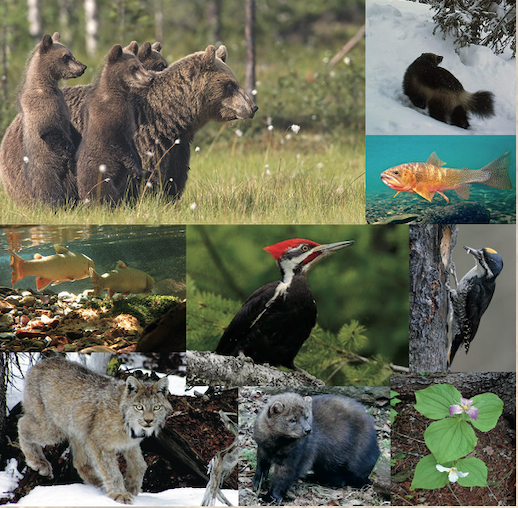
We’re working to protect this national treasure through our wildlife-focused Citizen Forest Plan:
- based on the best available scientific information;
- protects roadless areas, Wilderness Study Areas and streams as Proposed Wilderness and Wild & Scenic Rivers;
- establishes and restores linkages for wildlife including grizzly bears;
- protects water quality for humans and native fish bull trout and cutthroat trout;
- allows natural processes such as forest and insects to play a natural role in shaping the landscape.
Support the important work of the Flathead-Lolo-Bitterroot Citizen Task Force.
Sign-Up to Receive News on Forest Plan Revision and other issues.
Task Force Sends Notice of Intent to Sue Over Unpermitted Taking of Grizzly Bears
The Flathead-Lolo-Bitterroot Citizen Task Force of Missoula has sent a 60-day Notice of Intent (NOI) to sue the U.S. Fish & Wildlife Service and the State of Montana for violations of the federal Endangered Species Act (ESA). The NOI is required by the ESA and allows parties to attempt to settle differences prior to litigation..
Download the Intent to Sue (PDF)
Press Release (Word)
Sign the "Preserve the Wild Core of the Northern Rockies" Petition Today!
Tell the U.S. Forest Service to Support the Lolo-Bitterroot Partnership citizen plan to protect millions of acres of America’s Wild Public Lands
The Flathead, Lolo and Bitterroot National Forests are the heart of the U.S. Northern Rockies, comprising millions of acres of wildlands that belong to all American citizens. According to the Lolo National Forest, “Large, wild areas and a full suite of native species on the forest are nationally important and even merit global importance. The Lolo National Forest is situated within some of the wildest areas in the United States.”
Click here to Sign and Share our Change.org petiton.
Groups Release Longterm Plans for Lolo and Bitterroot National Forest
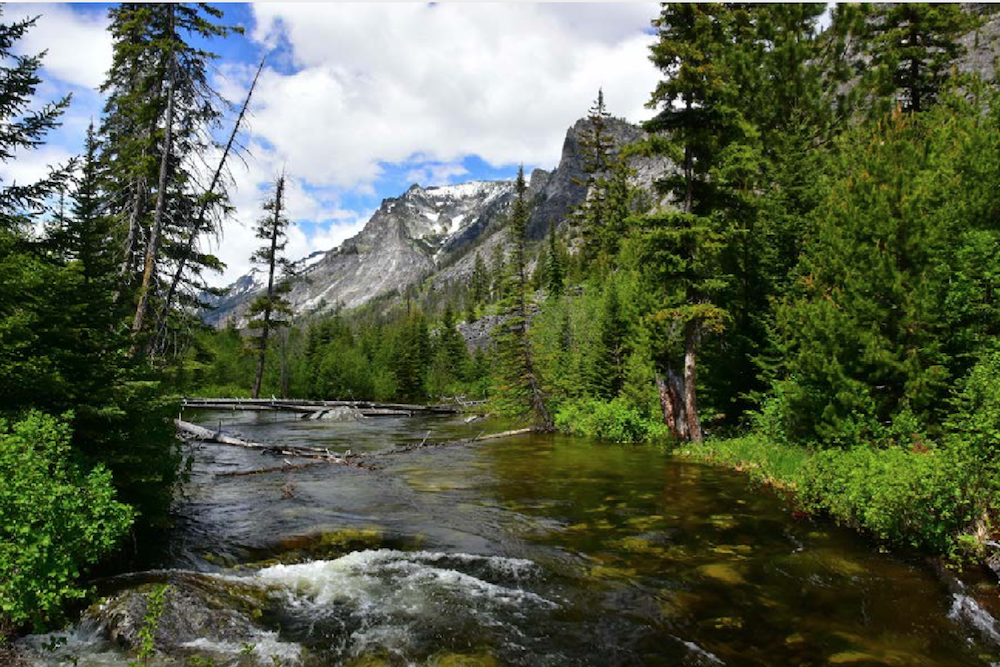 Western Montana-based organizations the Flathead-Lolo-Bitterroot Citizen Task Force and the Friends of the Bitterroot today released The Lolo-Bitterroot Partnership, a vision for the future of the Lolo and Bitterroot National Forests.
Western Montana-based organizations the Flathead-Lolo-Bitterroot Citizen Task Force and the Friends of the Bitterroot today released The Lolo-Bitterroot Partnership, a vision for the future of the Lolo and Bitterroot National Forests.
The two national forests are revising their Forest Plans, which will guide management activities for up to 30 years. The Lolo and Bitterroot National Forests contain nationally significant lands that are part of the largest remaining wildlands area in the lower 48 states retaining virtually all the species present at the time of the Lewis & Clark Expedition. They are also key connectivity areas linking the major blocks of wildlands in the Northern Rockies.
The goal is to have the Lolo-Bitterroot Partnership plan become one of the alternatives in the Forest Plan Revision process. Download the report (PDF).
Learn more: Citizens’ group proposes conservation-driven plan for western Montana forests, Missoula Current, 6/10/22
Endorsements of Lolo-Bitterroot Partnership Plan--Current through 6/15/22 (Download the PDF)
Groups, Scientists Oppose Montana Grizzly Hunting Plan
Download the Comments on the Draft Montana Statewide Grizzly Bear Management Plan and DEIS (PDF)
Task Force and Allies Comment on Proposed Massive BLM Logging in NCDE Grizzly Bear Habitat
Download the comments (PDF)
Research that Task Force Funded is Published in Science Journal
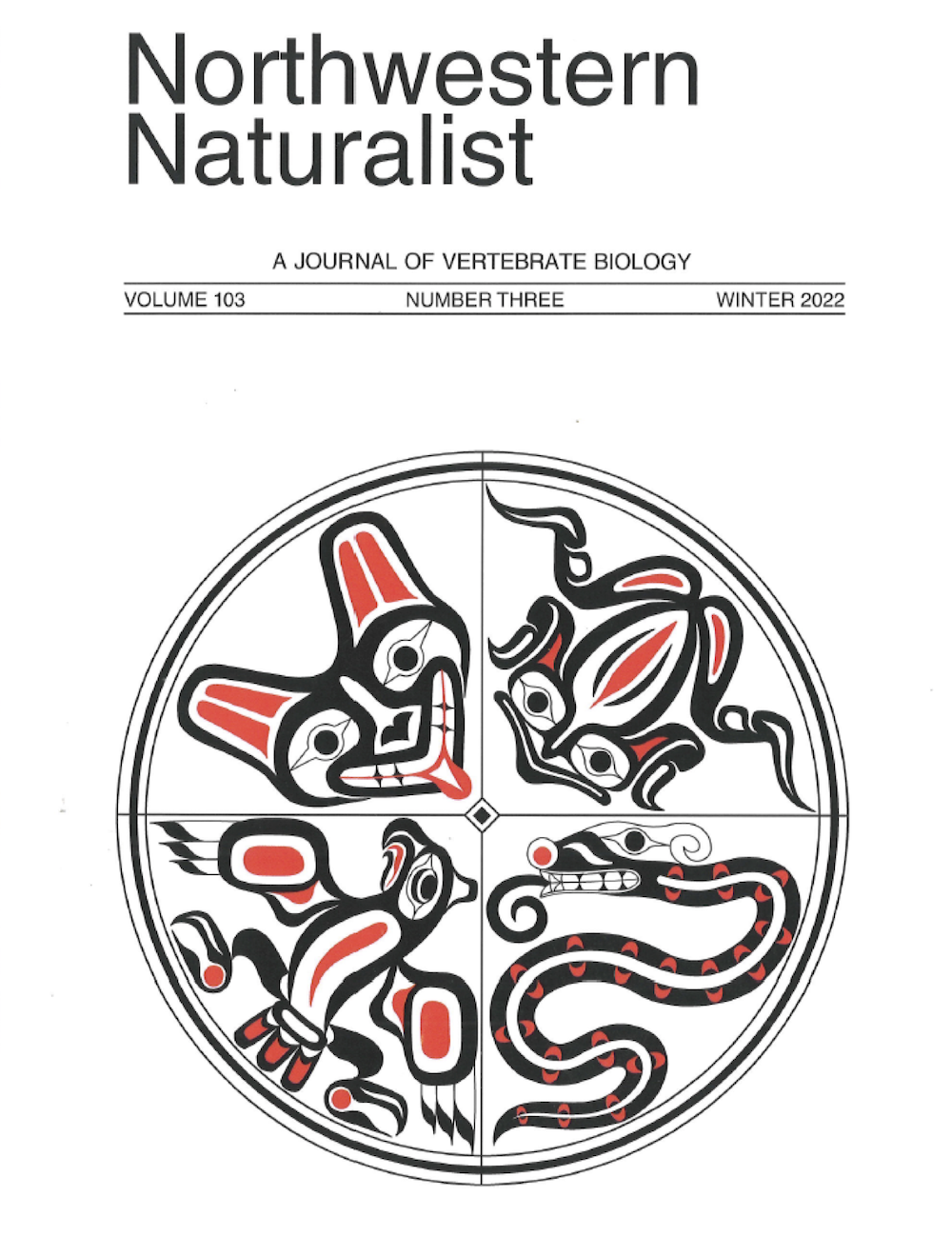 Download the Press Release (PDF)
Download the Press Release (PDF)
Download the Northwest Naturalist (PDF)
Task Force Praises Court Ruling Protecting Ninemile Grizzly Bears
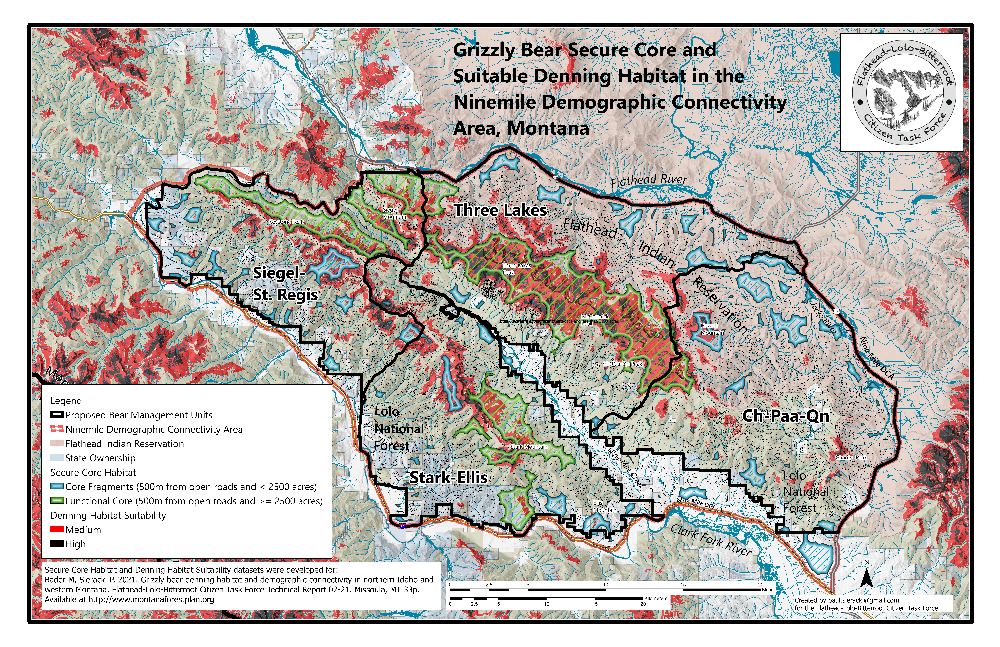 The Flathead-Lolo-Bitterroot Citizen Task Force praised the final ruling and order on the Soldier-Butler Project which upholds the Findings and Recommendations issued by Magistrate Judge Kathleen DeSoto. The Task Force sued the U.S. Fish & Wildlife Service and U.S. Forest Service over the Biological Opinion and Final Decision on the Soldier-Butler Project, a large roadbuilding and logging project in the Ninemile area of the Lolo National Forest northwest of Missoula. The Project would result in 16 miles of permanent and temporary roads and remove nearly 18 million board feet of logs in the heart of the designated Ninemile Demographic Connectivity Area for female grizzly bears and their cubs established by the Conservation Strategy for Grizzly Bears. All of the government’s objections to the findings and recommendations were overruled and all aspects of it upheld. The ruling and order come from federal Judge Dana Christensen.
The Flathead-Lolo-Bitterroot Citizen Task Force praised the final ruling and order on the Soldier-Butler Project which upholds the Findings and Recommendations issued by Magistrate Judge Kathleen DeSoto. The Task Force sued the U.S. Fish & Wildlife Service and U.S. Forest Service over the Biological Opinion and Final Decision on the Soldier-Butler Project, a large roadbuilding and logging project in the Ninemile area of the Lolo National Forest northwest of Missoula. The Project would result in 16 miles of permanent and temporary roads and remove nearly 18 million board feet of logs in the heart of the designated Ninemile Demographic Connectivity Area for female grizzly bears and their cubs established by the Conservation Strategy for Grizzly Bears. All of the government’s objections to the findings and recommendations were overruled and all aspects of it upheld. The ruling and order come from federal Judge Dana Christensen.
Court Ruling and Order on Soldier-Butler Project (PDF)
Judge Halts Forest Project, Missoulian, October 6, 2021 (PDF)
Wildlife Heritage Faces Assault, Opinion, Missoulian, October 14, 2021 (PDF)
Task Force Front Makes Page News on Soldier-Butler and Ninemile
Task Force field trip visit with Ninemile landowners gets front page news coverage in the Sunday, August 1, Missoulian. Download the Missoulian article (PDF)
Keep Informed & Get Involved
Groups We Frequently Work With
Friends of the Bitterroot | Friends of the Clearwater | Wilderness Watch | WildEarth Guardians
